List of natural monuments in Dillenburg
The list of natural monuments in Dillenburg called the in the field of city Dillenburg located natural monuments . They are registered with the lower nature conservation authority of the Lahn-Dill district (Environment, Nature and Water Department).
| image | designation | District, location | description | Art | No. |
|---|---|---|---|---|---|
 more pictures |
At the running stone Dillenburg | Dillenburg 50 ° 44 ′ 5.7 " N , 8 ° 17 ′ 46.9" E |
Exposure of the so-called “Dillenburg Formation”, which consists of diverse submarine deposits from the Upper Devonian.
Reason for protection: importance for science and teaching. |
Rock profile | 129 |

|
Book at the Dillenburg battery | Dillenburg 50 ° 44 ′ 20.8 " N , 8 ° 17 ′ 39.1" E |
About 200 years old, beautifully grown, conspicuous beech on the battery monument.
Reason for protection: beauty, cultural significance |
Single tree | 191 |

|
Thick oak Manderbach |
Manderbach 50 ° 46 '1.9 " N , 8 ° 15' 14.3" E |
Height 15 m, circumference 5.20 m.
Reason for protection: age, cultural significance |
Single tree | 170 |

|
Friedenslinde Dillenburg | Dillenburg 50 ° 45 ′ 10 ″ N , 8 ° 17 ′ 36.2 ″ E |
Planted in 1871 in memory of the peace treaty that same year. Height 22 m, circumference 1.80 m.
Reason for protection: memory of historical events. |
Single tree | 60 |
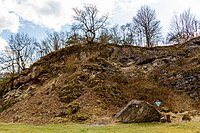
|
Donsbach municipal quarry |
Donsbach 50 ° 43 '17.9 " N , 8 ° 13' 54.6" E |
Quarry wall and funnel-shaped recessed excavation site (pinge). Geological outcrop with heavily folded Upper Devonian plate limestone, tuff and slate.
Reason for protection: Geological significance. |
Quarry | 122 |
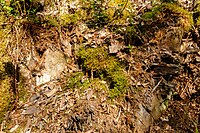 more pictures |
Dillenburg pen quarry | Dillenburg 50 ° 45 ′ 8.3 ″ N , 8 ° 17 ′ 31.5 ″ E |
Quarry made of slate that can be split in two levels and that has been processed into slate pencils.
Reason for protection: regional significance. |
Quarry | 195 |

|
Hartig beech Dillenburg | Dillenburg 50 ° 44 ′ 37 " N , 8 ° 17 ′ 34.5" E |
Strong, beautifully grown beech with a rocky cliff at the Hartig monument in memory of one of the founders of sustainable forestry.
Reason for protection: beauty, cultural significance. |
Single tree | 193 |
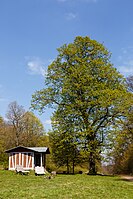
|
Kaiserlinde Dillenburg | Dillenburg 50 ° 45 ′ 8.4 " N , 8 ° 17 ′ 44.9" E |
Height 26.5 m, circumference 2.70 m. Planted in memory of the year of the three emperors in 1888.
Reason for protection: memory of historical events and people. |
Single tree | 59 |
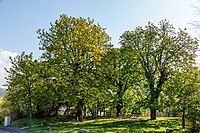
|
Chestnuts at Hof Feldbach Dillenburg | Dillenburg 50 ° 43 ′ 31.5 ″ N , 8 ° 17 ′ 26 ″ E |
Horse chestnuts. Height approx. 14 m, circumference 2.15 to 2.35 m.
Reason for protection: beauty |
Tree Group | 61 |

|
Linden tree on the Hübschbeul Nanzenbach |
Nanzenbach 50 ° 46 ′ 29.3 ″ N , 8 ° 20 ′ 8.9 ″ E |
Summer linden tree in an exposed location. Height 18 m, circumference 1.95 m.
Reason for protection: beauty |
Single tree | 151 |

|
Sheep Oak Manderbach |
Manderbach 50 ° 45 ′ 37.3 " N , 8 ° 16 ′ 38.2" E |
Hat oak on a former sheep pasture. Relic of a formerly important form of farming. Height 20 m, circumference 6.35 m.
Reason for protection: regional importance. |
Single tree | 74 |
 more pictures |
Snow trees in Nanzenbach |
Nanzenbach 50 ° 46 '33.7 " N , 8 ° 20' 3.6" E |
The only stock that is still regularly cut today. Evidence of historical rural land use. The leaves used to be used as bedding or forage.
Reason for protection: individual character, cultural significance. |
Trees | 194 |

|
Quarry in the Schelden Valley Eibach |
Eibach 50 ° 44 ′ 57.1 ″ N , 8 ° 21 ′ 2.5 ″ E |
Former quarry of the "Beilstein" pit. Exceptional occurrence of pillow diabase in the form of a brecciated mass.
Reason for protection: Geological significance. |
Geological outcrop | 130 |

|
Donsbach juniper stand |
Donsbach 50 ° 43 ′ 23.3 " N , 8 ° 12 ′ 48.7" E |
Relic of historical land use through sheep grazing.
Reason for protection: Geological significance. |
Juniper stand | 140 |
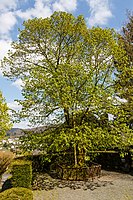
|
Wilhelmslinde Dillenburg | Dillenburg 50 ° 44 ′ 12.9 ″ N , 8 ° 17 ′ 8.7 ″ E |
Winter linden. Height 12 m, circumference 2.15 m. Branch of the linden tree under which William of Orange received the Dutch ambassadors in 1568.
Reason for protection: cultural and historical significance |
Single tree | 40 |